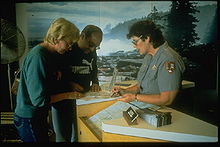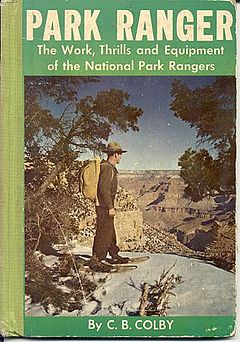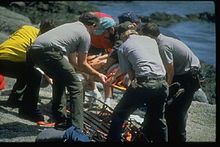- National Park Service Ranger
-
National Park Service Rangers are among the uniformed employees charged with protecting and preserving areas set aside in the National Park System by the United States Congress and/or the President of the United States. While all employees of the agency contribute to the National Park Service mission of preserving unimpaired the natural and cultural resources set aside by the American people for future generations, the term Park Ranger is traditionally used to describe all National Park Service employees who wear the uniform. Broadly speaking, all National Park Service rangers promote stewardship of the resources in their care - either voluntary stewardship via resource interpretation, or compliance with statute or regulation through law enforcement. These comprise the two main disciplines of the ranger profession in the National Park Service.
Contents
History
The origin of the term "ranger" dates to the 14th century in England, and was drawn from the word "range" (to travel over a large area). "Rangers" patrolled royal forests and parks to prevent "poachers" from hunting game belonging to the crown.[1] The title "Ranger" in the modern sense was first applied to a reorganization of the Fire Warden force in the Adirondack Park, after 1899 when fires burned 80,000 acres (320 km2) in the park. The name was taken from Rogers' Rangers, a small force famous for their woodcraft that fought in the area during the French and Indian War beginning in 1755. The term was then adopted by the National Park Service[2]
The first Director of the National Park Service, Stephen T. Mather, reflected upon the early park rangers as follows:
They are a fine, earnest, intelligent, and public-spirited body of men, these rangers. Though small in number, their influence is large. Many and long are the duties heaped upon their shoulders. If a trail is to be blazed, it is "send a ranger." If an animal is floundering in the snow, a ranger is sent to pull him out; if a bear is in the hotel, if a fire threatens a forest, if someone is to be saved, it is "send a ranger." If a Dude wants to know the why, if a Sagebrusher is puzzled about a road, it is "ask the ranger." Everything the ranger knows, he will tell you, ex-cept about himself.[3]
Horace Albright, second director of the National Park Service, called Harry Yount, gamekeeper of Yellowstone National Park, the "father of the ranger service, as well as the first national park ranger".[3]
Official Classification
The Park Ranger position in the Federal Government began as a series of specialized positions in the miscellaneous Series. In 1959 the official Park Ranger position (GS-0025 Park Ranger) was established throughout the Federal Government.[4] along with its companion series the Park Technician (GS-0026). The Park Ranger position was designated for 'professional' work like management of the park (Park Ranger (Manager)-Park Ranger(Site Manager)), or management of division (Chief Ranger, Chief of Interpretation). The Park Technician series was designed to handle routine technical skills, i.e., giving walks, talks, patrolling roads, fee collection.[4]After years of concern of pay, the National Park Service and the Office of Personnel Management agreed to consolidate the two series into a single group, to be used only for professional positions and temporary/seasonal positions. The agreement also required that the park service begin using other appropriate technical series for lower paid positions.[4] The Protection Ranger series was changed to "GL"-0025 in 2005.
- 0025 – Park Ranger Series*
The duties are to supervise, manage, and/or perform work in the conservation and use of Federal park resources. This involves functions such as park conservation; natural, historical, and cultural resource management; and the development and operation of interpretive and recreational programs for the benefit of the visiting public.[5]
Beginning in 1985, the service made this adjusment.[clarification needed][citation needed] Today, Park Ranger like duties are handled by a range of employees, wearing the traditional 'green and gray' uniforms, who are not park rangers.[citation needed] These positions include:
- 0303 – Miscellaneous Clerk and Assistant Series, aka Visitor Use Assistances. Duties include clerical, assistant, or technician work when other series are not appropriate. The work requires a knowledge of procedures and techniques involved in handling special program. This series is commonly used for Fee Collectors at campgrounds and entrance stations.[5]
- 0189 – Recreation Aid and Assistant Series. Provides support to recreation programs by performing limited aspects of recreation work, lifequards[5]
- 0090 – Guide Series. Provides or supervises interpretive and guide services to visitors to sites of public interest. Gives formal talks about natural and historic features, explains engineering structures and related water developments, answers questions, and guides tours.[5][6]
Duties, disciplines, and Specializations
The duties of the modern park ranger are as varied and diverse as the parks where they serve, and in recent years have become more highly specialized - though they often intertwine. Regardless of the regular duties of any one discipline, the goal of all rangers remains to protect the park resources for future generations and to protect park visitors. This goal is accomplished by the professionalism and sometimes overlapping of the different functions and specialties. For example, an interpretive ranger may be trained in and perform fire suppression, emergency medicine, or search & rescue. Law enforcement rangers and other park employees may contribute to the mission of the interpretive ranger by helping park visitors make a personal connection to park resources, and/or appropriately utilize facilities. The spirit of teamwork in accomplishing the mission of stewardship is underscored by the fact that in many cases, the U.S. National Park Service in particular, park rangers share a common uniform regardless of work assignment.
The oldest source of information on Park Ranger Careers was the 1956 Park Ranger by C.B. Colby. At that time, park rangers fulfilled all the demands of park operations from administrative duties to technical rescue. By 1995, Exploring Careers in the National Parks by Bob Gartner reflected the specialization of duties and the expansion of titles covering the same work as was being done in 1956. In the 21st century Live the Adventure showed the park ranger profession was only becoming more complex.
The federal Office of Personnel Management sums up the diversity of the official "Park Ranger Series" of professional white collar occupational groups as follows:
"This series covers positions the duties of which are to supervise, manage, and/or perform work in the conservation and use of Federal park resources. This involves functions such as park conservation; natural, historical, and cultural resource management; and the development and operation of interpretive and recreational programs for the benefit of the visiting public. Duties characteristically include assignments such as: forest and structural fire control; protection of property from natural or visitor related depredation; dissemination to visitors of general, historical, or scientific information; folk-art and craft demonstration; control of traffic and visitor use of facilities; enforcement of laws and regulations; investigation of violations, complaints, trespass/encroachment, and accidents; search and rescue missions; and management activities related to resources such as wildlife, lakeshores, seashores, forests, historic buildings, battlefields, archeological properties, and recreation areas."[7]
Interpretation Rangers
- Interpretation: Park Rangers provide a wide range of informational services to visitors. Some Rangers provide practical information—such as driving directions, train timetables, weather forecasts, trip planning resources, and beyond. Rangers may provide interpretive programs to visitors intended to foster stewardship of the resources by the visitor. Interpretation in this sense includes (but is not limited to): guided tours about the park's history, ecology or both; slideshows, talks, demonstrations; informal contacts, and historical re-enactments. All uniformed rangers, regardless of their primary duties, are often expected to be experts on the resources in their care, whether they are natural or cultural.
- Education: Rangers may also engage in leading more formalized curriculum-based educational programs, meant to support and complement instruction received by visiting students in traditional academic settings. Rangers often develop education programs to help educators meet specific national and/or local standards of instruction. Cultural resource education may include access to artifacts or replicas, and natural resource education may include the taking of samples, all under the supervision of a ranger to insure proper protection of the resources. Unlike interpretation, education programs will include the opportunity to assess learning.
Law Enforcement Rangers
By the 1970s the National Park Service recognized that in order to protect visitors and park resources effectively the service need professional rangers dedicated primarily to law enforcement, emergency medical services, firefighting, and search and rescue. Although some modern NPS Rangers in this specialty ("protection rangers") may be primarily engaged in law enforcement duties, the many varied environments they work in may require these employees to be competent in a variety of public safety skills. Rangers who have received a law enforcement commission wear the standard NPS uniform with the Department of the Interior law enforcement badge. In larger park units search and rescue, emergency medicine, and other functions may be a branch of the "visitor services" or "protection" division and may not require a commission. The following list describes the typical duties of a typical protection ranger:
- Law enforcement: Commissioned (sworn peace officer) rangers are federal law enforcement officers with broad authority to enforce federal and state laws within National Park Service sites. In units of the National Park System, law enforcement Rangers are the primary police agency; their services may be augmented by the United States Park Police, particularly in the Washington, New York City, and San Francisco metropolitan areas. The U.S. National Park Service also employs "special agents" who conduct more complex criminal investigations. Rangers, Agents and Park Police Officers receive extensive police training at the Federal Law Enforcement Training Center and annual in-service and regular firearms training. According to Department of Justice statistics NPS Law Enforcement Rangers suffer the most number of felonious assaults, and the highest number of homicides of all federal law enforcement officers.[8]
Emergency services
- Emergency Medical Response: Rangers are often certified as Wilderness First Responders, Emergency Medical Technicians or Paramedics. Rangers operate ambulances and respond to medical incidents ranging from bumps and bruises to heart attacks.
- Firefighting: Rangers are often the first to spot wildland fires and are often trained to engage in wild land firefighting; in some parks, rangers also carry out prescribed fires, and perform structural fire fighting duties.
- Search and Rescue: The wilderness aspect of many areas of the National Park System offers unique natural hazards for visitors. Search and Rescue trained rangers help visitors with injuries or illnesses suffered in remote wilderness areas or who become stranded in technical environments like swift water and high angle rock. These rangers are often expert climbers, boaters, or managers of the Incident Command System. Searches can range from children who wander away from Visitor Centers to expert climbers who suffer a major accident while climbing.
Education
Interpretation
In the last decades of the 20th century the field of resource interpretation began to consciously professionalize itself. This has resulted in the early 21st century with colleges and universities offering coursework and degrees in interpretation.[9][10][11]
Protection Management
All law enforcement officers are required to complete law enforcement training. Summer or seasonal law enforcement officers must complete an approved Seasonal Law Enforcement Training Program (SLETP). The SLETP program, an abbreviated law enforcement training program, was developed in 1977 to ensure that temporary park rangers have the appropriate skills and judgement to carry out law enforcement duties.[12]
SLETP approved programs:
College[12] Location Contact Number Contact website Colorado Northwestern Community College Rangely, Colorado 800-562-1105, ext 331 [2] Hocking College Nelsonville, Ohio 740-753-6295 [3] Northern Arizona University Flagstaff, Arizona 928-523-8242 [4] Santa Rosa Junior College Windsor, California 707-836-2914 [5] Skagit Valley College Mount Vernon, Washington [6] Slippery Rock University Slippery Rock, Pennsylvania 724-738-2596 [7] Southwestern Community College Franklin, North Carolina 828-369-0591 [8] University of Massachusetts Amerherst Hadley, Massachusetts 413-545-2484 [9] Vermilion Community College Ely, Minnesota 218-365-7265 [10] Permanent employees are required to complete the National Park Service's curriculum at the Federal Law Enforcement Training Center (F.L.E.T.C.) in Glynco, Georgia, where they attend a lengthy and rigorous law enforcement training program. The permanent Ranger is then assigned a Field Training Park and upon completion returns to their duty station.
See also
References
- ^ [1]
- ^ Angus, Christopher, The Extraordinary Adirondack Journey of Clarence Petty, Syracuse: Syracuse University Press, 2002. ISBN 0-8156-0741-5.
- ^ a b Albright, Horace M.; Taylor, Frank J. (1929). "Oh, Ranger!" A Book about the National Parks. Stanford University Press. pp. 5–7. ISBN 978-1440080227. http://books.google.com/books?id=ITKNBfOZ-hcC&printsec=frontcover.
- ^ a b c POSITION CLASSIFICATION STANDARD FOR PARK RANGER SERIES, GS-0025; Office of Personnel Management; TS-75 November 1985
- ^ a b c d Handbook of Occupational Groups and Families May 2009; Office of Personnel Management; Washington D.C.
- ^ Position Classification Standard for Guide Series, GS-0090; Office of Personnel Management; TS-37 December 1961
- ^ U.S. Office of Personnel Management. Handbook of occupational groups and families. Washington, D.C. January 2008. Page 19. OPM.gov Accessed January 2, 2009.
- ^ "U.S. Rangers, Park Police Sustain Record Levels of Violence." Environmental News Service. 2004. Ens-Newswire.com
- ^ http://www.uafortsmith.edu/HSS/HistoricalInterpretation
- ^ http://www2.sfasu.edu/msri/index.htm
- ^ http://www.gordon.edu/museum-studies
- ^ a b Seasonal Law Enforcement Training Program; Association of National Park Rangers, October 2009
External links
Categories:- Public safety
- United States National Park Service
- Law enforcement occupations
- 0025 – Park Ranger Series*
Wikimedia Foundation. 2010.



